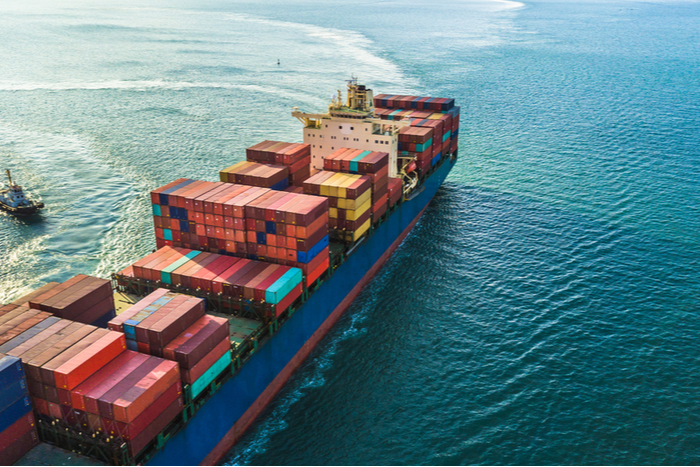
Asia–North America vessel on-time performance in October plunged to 32.1 percent to the West Coast and 34.5 percent to the East Coast. Photo credit: Shutterstock.com.
Eastbound trans-Pacific ocean reliability plummeted in October to its lowest since data collection began in 2011 as carriers rapidly expanded their capacity to meet growing cargo demand, contributing to mounting congestion at the ports of Los Angeles and Long Beach.
Vessel on-time performance in the Asia–North American trade plunged more than 14 percentage points from September to 32.1 percent to the West Coast and 34.5 percent to the East Coast, according to the Global Liner Performance report from Sea-Intelligence Maritime Analysis.
The further deterioration in ocean reliability can be seen in vessel bunching this week at the Los Angeles-Long Beach port complex, where 20 container ships were waiting at anchor as of Monday, according to the Marine Exchange of Southern California.
“As carriers continue to increase capacity in the lead-up to the holiday season, schedule reliability keeps dropping,” Sea-Intelligence Maritime Analysis said Monday.
Most of the major shipping lines, and all three of the vessel-sharing alliances, experienced degraded schedule reliability globally as container volumes increased rapidly this summer with the reopening of national economies after the initial wave of shutdowns owing to the COVID-19 pandemic.
“Essentially, global schedule reliability has been in freefall since August 2020, and since we initiated the detailed measurements in 2011, the market has never seen such a rapid deterioration,” Sea-Intelligence Maritime Analysis said.
Globally, carrier on-time performance in October reached a record low 52.4 percent. That was down 3.6 percentage points from September and 26.7 percentage points from October 2019. The average vessel delay globally in October was 4.86 days, up from 4.11 days in October 2019.
Late vessel arrivals in Southern California have added to the congestion problems that have plagued the ports of Los Angeles and Long Beach since late June. The Southern California supply chain continues to suffer from congested marine terminals, excessive container dwell times at the terminals, lengthy truck wait times at the gates, chassis shortages, and distribution warehouses filled beyond capacity.
Vessel bunching
Although 20 vessels awaited anchor on Monday, J. Kipling Louttit, executive director of the Marine Exchange of Southern California, said, “There is good flow, with a mix of vessels going to berth directly, to anchor, or shifting to berth.” Another 16 container ship arrivals are scheduled for Tuesday through Thursday, he said.
Sea-Intelligence Maritime Analysis said its global analysis of carrier on-time performance points to a series of factors and market conditions beyond any individual carrier’s ability to control. Those conditions often involve port congestion at both ends of the voyage, which leads to vessel delays in departure and arrival. As vessels spend more time in the receiving port, terminals become congested and vessel unloading is delayed.
In Southern California, the supply chain has been further stressed on the landside. The receiving warehouses are so full that loaded import container/chassis units are left sitting outside the facilities. This delays the return of the empty container/chassis units to the marine terminals, which in turn has created a shortage of chassis in the supply chain.
Although Los Angeles-Long Beach has experienced the greatest amount of congestion owing to the record of US imports from Asia, congestion has also mounted recently in the Port of New York and New Jersey owing to the surge in volume.
Contact Bill Mongelluzzo at bill.mongelluzzo@ihsmarkit.com and follow him on Twitter: @billmongelluzzo.
"low" - Google News
December 01, 2020 at 05:26AM
https://ift.tt/2I3XXv0
Asia-US ocean reliability falls to new low - JOC.com
"low" - Google News
https://ift.tt/2z1WHDx
Bagikan Berita Ini














0 Response to "Asia-US ocean reliability falls to new low - JOC.com"
Post a Comment